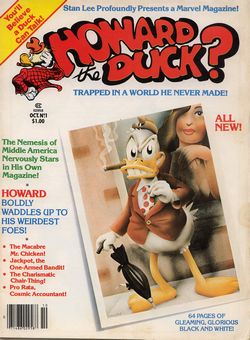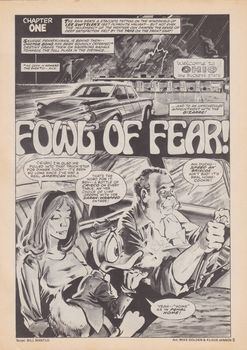no 1 fowl of fear
| série: | Howard the Duck |
| dessinateur / scénariste: | Collectif |
| éditeur: | Marvel USA |
| genre: | Humour Noir |
| classement: | carton131 |
| date: | 1979 |
| format: | broché |
| état: | TBE |
| valeur: | 10 € |
| critère: | * |
| remarques: | Howard the Duck, serie 2958, 9 issues from no 1 October 1979 to no 9 March 1981, all black and white the number 9 is missing in present collection n.b. not to be confused with color edition running from no 1 January 1976 to no 33 September 1986 - Howard the Duck whose home is in Cleveland, Ohio he lives with his girl friend Beverly Switzler, the duck who hates water but likes to smoke cigar hsi adventures are supposed nonsense stories supposed to be a satire on American culture and society, not always interesting for reading but generally a very good design by Gene Colan n.b. the name Howard is a Scandinavian baby name, in Scandinavian the meaning of the name Howard is: noble watchman, surname also of one of the great houses of English nobility 1/ editorial greetings from Cleveland, city of light and magic this magazine marks the firm, confident waddle of our hero into a new phase of his career: graduating from a color comic book to a black and white magazine, Duck's stories can now be nearly four times longer (but not necessarily more interesting, note of the reader!) Howard the Duck, fowl of fear by Bill Mantlo and Mike Golden Information Howard the Duck is a fictional character appearing in American comic books published by Marvel Comics, the character was created by writer Steve Gerber and artist Val Mayerik, Howard the Duck first appeared in Adventure into Fear #19 (cover-dated Dec. 1973) and several subsequent series have chronicled the misadventures of the ill-tempered, anthropomorphic "funny animal" trapped on a human-dominated earth Howard's adventures are generally social satires, while a few are parodies of genre fiction with a metafictional awareness of the medium,. the book is existentialist, and its main joke, according to Gerber, is that there is no joke: "that life's most serious moments and most incredibly dumb moments are often distinguishable only by a momentary point of view" this is diametrically opposed to screenwriter Gloria Katz who, in adapting the comic to the screen, declared, "it's a film about a duck from outer space... it's not supposed to be an existential experience" Howard the Duck was portrayed by Ed Gale and voiced by Chip Zien in the 1986 Howard the Duck film adaptation and was later voiced by Seth Green in the film Guardians of the Galaxy and Guardians of the Galaxy Vol. 2. Howard the Duck was created by writer Steve Gerber and penciler Val Mayerik in Adventure into Fear #19 (Dec. 1973) as a secondary character in that comic's "Man-Thing" feature he graduated to his own backup feature in Giant-Size Man-Thing #4–5 (May and Aug. 1975), confronting such bizarre horror-parody characters as Garko the Man-Frog and Bessie the Hellcow, before acquiring his own comic book title with Howard the Duck #1 in 1976 Gerber wrote 27 issues of the series (for the most part ditching the horror parodies), illustrated by a variety of artists, beginning with Frank Brunner for Gerber, Howard was a flesh and blood duck and that, "if Wile E. Coyote gets run over by a steamroller, the result is a pancake-flat coyote who can be expected to snap back to three dimensions within moments; if Howard gets run over by a steamroller, the result is blood on asphalt" Gene Colan became the regular penciller with issue #4, Gerber later said to Colan: "There really was almost a telepathic connection there I would see something in my mind, and that is what you would draw! I've never had that experience with another artist before or since" sporting the slogan "Get Down, America!", the All-Night Party was a fictional political party that appeared in Gerber's Howard the Duck series during the U.S. Presidential campaign of 1976 and led to Howard the Duck receiving thousands of write-in votes in the actual election, Gerber addressed questions about the campaign in the letters column of the comic book and, as Mad Genius Associates, sold merchandise publicizing the campaign Marvel attempted a spin-off with a short-lived Howard the Duck newspaper comic strip from 1977 to 1978, at first written by Gerber and drawn by Colan and Mayerik, later written by Marv Wolfman and drawn by Alan Kupperberg Gerber gained a degree of creative autonomy when he became Howard the Duck 's editor, in addition to his writing duties, with issue #16, unable to meet the deadline for his regular script, Gerber substituted an entire issue of text pieces and illustrations satirizing his own difficulties as a writer In 1978, the writer and publisher clashed over issues of creative control, and Gerber was abruptly removed from the series, on August 29, 1980, after learning of Marvel's efforts to license Howard for use in film and broadcast media, Gerber filed a copyright infringement lawsuit against Marvel corporate parent Cadence Industries and other parties, alleging that he was the sole owner of the character, this was one of the first highly publicized creator's rights cases in American comics and attracted support from major industry figures, some of whom created homage/parody stories with Gerber to fund a lawsuit against Marvel; these included Destroyer Duck with Jack Kirby the lawsuit was settled on September 24, 1982, with Gerber acknowledging that his work on the character was done as work-for-hire and that Marvel parent Cadence Industries owned “all right, title and interest” to Howard the Duck and the Howard material he had produced on November 5, 1982, Judge David Kenyon approved the motion and dismissed the case plot Howard the Duck was born on Duckworld, a planet in another dimension, where intelligent life evolved from waterfowl, Duckworld is apparently an alternate Earth, and resembles mankind's Earth in an astounding number of ways, including the fact that ducks speak English, very little is known about Howard's past on Duckworld, indeed, there are conflicting accounts as to the circumstances surrounding his disappearance Howard is abducted from his home planet and is dropped into the Florida Everglades by the demon Thog the Nether-Spawn, Overmaster of the realm of Sominus, he meets the Man-Thing, Korrek the Barbarian, Dakimh the Enchanter and Jennifer Kale, but falls off the inter-dimensional stepping stones, he materializes in Cleveland, Ohio and battles Garko the Man-Frog, for which he is arrested for disturbing the peace and mistaken for a mutant during a strip search, released because the police fear he has mutant abilities, he encounters Bessie the Hellcow, a vampire cow Howard makes friends with an artists' model named Beverly Switzler and a bizarre series of encounters follow, he battles Pro-Rata, the cosmic accountant, then meets Spider-Man at the end of the battle, he battles Turnip-Man and the Kidney Lady, then learns Quak Fu, encounters the Winky Man, a sleepwalking alter ego of Beverly's artist friend, Paul Same, who would become a series regular (and share the apartment), and becomes a wrestler Howard has no superhuman powers, but he is skilled in the martial art known as Quak-Fu, enough to defeat, or to at least hold his own against far larger opponents, he has shown some degree of mystic talent in the past, to the point that Stephen Strange taught some spells to Howard and even offered to train him, but Howard declined on occasion, Howard used a suit of powered armor, known as the "Iron Duck" designed by Claude Starkowitz, besides its property as body armor, the suit was equipped with foot-mounted leaping coils, a chest-mounted searchlight and flamethrowers in both arms |
| couvertures: |   |
Copyright 2008 - 2025 G. Rudolf
